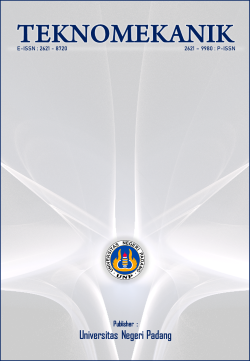Synthesis Optimization of Cathode Precursor Ni0,5 Mn0,4 Co0.1 (OH)2 with Coprecipitation Method
DOI:
https://doi.org/10.24036/jptk.v6i1.30523Keywords:
NMC541, Co-precipitation, Aging, Steering speedAbstract
The use of conventional fuels such from fossils sourced is non-renewable energy, which makes this energy source less environmentally friendly. The battery that is nowadays used widely is the Lithium-Ion type with variations in the type of electrode. Electrodes have an important role in battery performance, especially at the cathode. Predecessor cathode types such as LiCoO2, LiMnO, and LiNiCo have various disadvantages due to their dangerous nature, insufficient capacity, and poor stability. NMC cathode (NiMnCo), in this case, NMC541 is presented to overcome these deficiencies. The process of making NMC541 cathode can be done by various synthesis methods, one of which is Co-precipitation. The synthesis parameter directly influences the performance of the cathode precursor produced, especially on its microstructure. For that, we try to optimize the synthesis parameters, such as Stirring Speed, and Aging time. The result said that samples with 900 Rpm stirring speed give the best product precursor along to their small size particle and good conductivity. Meanwhile, Aging co-precipitation doesn’t significantly affect coprecipitation precursor products.
Downloads
References
El Mofid, W., Ivanov, S., & Bund, A. (2014). Effect of synthesis conditions and composition modification on the structural and electrochemical properties of layered transition metal oxide cathode materials. Proceedings of 2014 International Renewable and Sustainable Energy Conference, IRSEC 2014, June 2018, 626–630. https://doi.org/10.1109/IRSEC.2014.7059798
Jeong, Y., Kim, I., Yeon, J., Yan, N., Jeong, H., Ki, J., Ho, J., & Chul, J. (2016). Journal of Molecular Catalysis A : Chemical Effect of the aging time of the precipitate on the activity of Cu / ZnO catalysts for alcohol-assisted low temperature methanol synthesis. “Journal of Molecular Catalysis. A, Chemical,” 418–419, 168–174. https://doi.org/10.1016/j.molcata.2016.03.044
Liang, L., Du, K., Peng, Z., Cao, Y., Duan, J., Jiang, J., & Hu, G. (2014). Co-precipitation synthesis of Ni0.6Co0.2Mn 0.2(OH)2 precursor and characterization of LiNi 0.6Co0.2Mn0.2O2 cathode material for secondary lithium batteries. Electrochimica Acta, 130, 82–89. https://doi.org/10.1016/j.electacta.2014.02.100
Liu, J., Duan, Q., Qi, K., Liu, Y., Sun, J., Wang, Z., & Wang, Q. (2022). Capacity fading mechanisms and state of health prediction of commercial lithium-ion battery in total lifespan. Journal of Energy Storage, 46, 103910. https://doi.org/https://doi.org/10.1016/j.est.2021.103910
Portemer, F., Delahaye‐Vidal, A., & Figlarz, M. (1992). Characterization of Active Material Deposited at the Nickel Hydroxide Electrode by Electrochemical Impregnation. Journal of The Electrochemical Society, 139(3), 671. https://doi.org/10.1149/1.2069283
Voorhees, P. W. (1985). The theory of Ostwald ripening. Journal of Statistical Physics, 38(1), 231–252. https://doi.org/10.1007/BF01017860
Zhang, B., Li, L., & Zheng, J. (2012). Characterization of multiple metals (Cr, Mg) substituted LiNi0.8Co0.1Mn0.1O2 cathode materials for lithium ion battery. Journal of Alloys and Compounds, 520, 190–194. https://doi.org/https://doi.org/10.1016/j.jallcom.2012.01.004
Downloads
Published
How to Cite
Issue
Section
License
Copyright (c) 2023 Muhammad Abdul Razak, Anne Zulfia

This work is licensed under a Creative Commons Attribution 4.0 International License.





